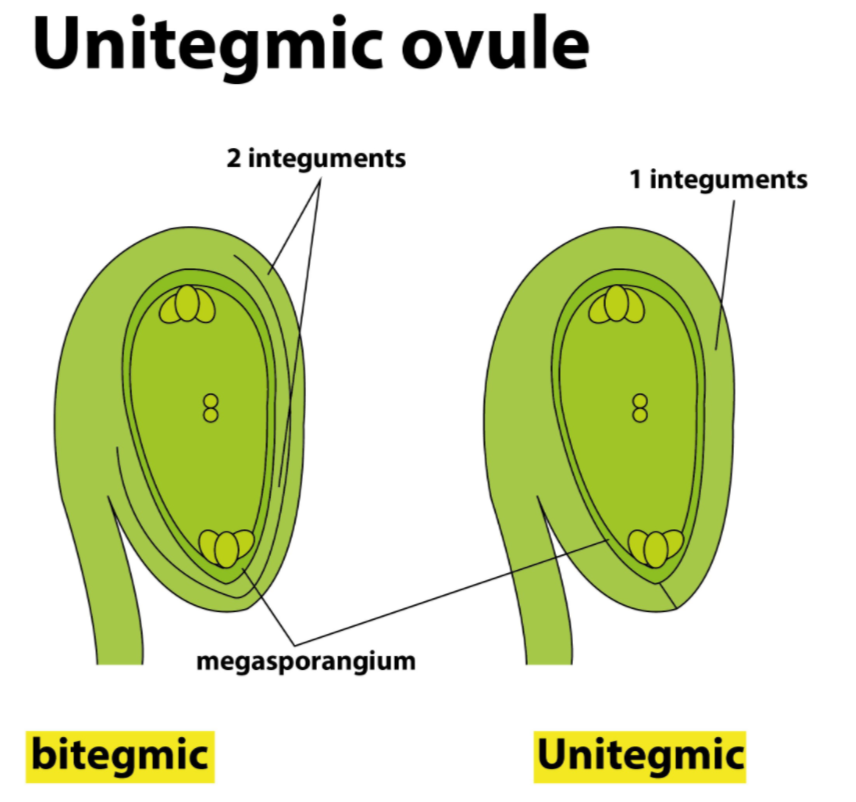
Which condition is more advanced?
(A) Bitegmic
(B) Unitegmic
(C) Tritegmic
(D) Ategmic
Answer
570.6k+ views
Hint: Here the discussion is regarding integuments which are protective layers around the ovule. Conditions which are more advanced are seen in gymnosperms. They have only one integument present in the ovule. An example of a single integument in ovule is the palm, pine, and many more.
Complete step by step answer:
Unitegmic is the most advanced condition. It is usually seen that the less the number of integuments present in the ovule, the more advanced the integuments in its properties and function. An integument is a protective layer that surrounds the ovule of the plant.There are four types of integuments on the basis of the number of layers present in it.
- Unitegmic: Ovules which have only one integument in it. Gymnosperms have a unitegmic ovule.
- Bitegmic: Ovules which have only two integuments in it. Angiosperms have a bitegmic ovule.
- Tritegmic: Ovules which have only three integuments in it. Litchi has a tritegmic ovule.
- Ategmic: Ovules which have no integument in it. Some parasites like Viscum have ategmic ovules.

So, the correct answer is ‘Unitegmic’.
Additional Information: The integuments become the testa when the ovule matures after fertilization. The integuments don't enclose the nucellus completely but retain a gap at the apex mentioned as the micropyle. The micropyle opening allows the male gametophyte which is pollen to enter the ovule for fertilization. In gymnosperms, the pollen is drawn into the ovule on a drop of fluid that discharges out of the micropyle, the so-called pollination drop mechanism. Subsequently, the micropyle closes. In angiosperms, only a plant part enters the micropyle. During germination, the radicle comes out through the micropyle.
Note: A few angiosperms produce plant vascular tissue within the outer integument, the orientation of which suggests that the outer surface is morphologically abaxial. This means that cupules of the type produced by the Caytoniales or Glossopteridales may have evolved into the outer integument of angiosperms.
Complete step by step answer:
Unitegmic is the most advanced condition. It is usually seen that the less the number of integuments present in the ovule, the more advanced the integuments in its properties and function. An integument is a protective layer that surrounds the ovule of the plant.There are four types of integuments on the basis of the number of layers present in it.
- Unitegmic: Ovules which have only one integument in it. Gymnosperms have a unitegmic ovule.
- Bitegmic: Ovules which have only two integuments in it. Angiosperms have a bitegmic ovule.
- Tritegmic: Ovules which have only three integuments in it. Litchi has a tritegmic ovule.
- Ategmic: Ovules which have no integument in it. Some parasites like Viscum have ategmic ovules.

So, the correct answer is ‘Unitegmic’.
Additional Information: The integuments become the testa when the ovule matures after fertilization. The integuments don't enclose the nucellus completely but retain a gap at the apex mentioned as the micropyle. The micropyle opening allows the male gametophyte which is pollen to enter the ovule for fertilization. In gymnosperms, the pollen is drawn into the ovule on a drop of fluid that discharges out of the micropyle, the so-called pollination drop mechanism. Subsequently, the micropyle closes. In angiosperms, only a plant part enters the micropyle. During germination, the radicle comes out through the micropyle.
Note: A few angiosperms produce plant vascular tissue within the outer integument, the orientation of which suggests that the outer surface is morphologically abaxial. This means that cupules of the type produced by the Caytoniales or Glossopteridales may have evolved into the outer integument of angiosperms.
Recently Updated Pages
Why are manures considered better than fertilizers class 11 biology CBSE

Find the coordinates of the midpoint of the line segment class 11 maths CBSE

Distinguish between static friction limiting friction class 11 physics CBSE

The Chairman of the constituent Assembly was A Jawaharlal class 11 social science CBSE

The first National Commission on Labour NCL submitted class 11 social science CBSE

Number of all subshell of n + l 7 is A 4 B 5 C 6 D class 11 chemistry CBSE

Trending doubts
Differentiate between an exothermic and an endothermic class 11 chemistry CBSE

10 examples of friction in our daily life

One Metric ton is equal to kg A 10000 B 1000 C 100 class 11 physics CBSE

Difference Between Prokaryotic Cells and Eukaryotic Cells

1 Quintal is equal to a 110 kg b 10 kg c 100kg d 1000 class 11 physics CBSE

State the laws of reflection of light




